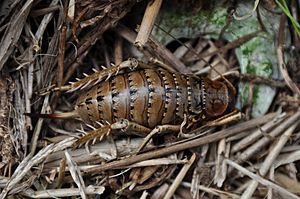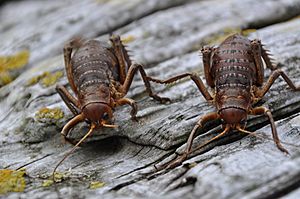Deinacrida carinata facts for kids
Quick facts for kids Foveaux Strait giant wētā |
|
|---|---|
 |
|
| Conservation status | |
 Nationally Endangered (NZ TCS) |
|
| Scientific classification | |
| Genus: |
Deinacrida
|
| Species: |
carinata
|
The Deinacrida carinata, also known as the Herekopare wētā or Foveaux wētā, is one of the smallest types of giant wētā. These amazing insects belong to a group called Deinacrida and are part of the Anostostomatidae family. They are found only in New Zealand and currently live on a few special islands where there are no predators. These islands include Herekopare Island, Kundy Island, Tihaka/Pig Island, and Whenua Hou/Codfish Island. The Foveaux Strait giant wētā is a protected species and is considered nationally endangered.
Contents
What Does It Look Like?
The Deinacrida carinata is the smallest kind of giant wētā. Its body is usually about 25 to 40 millimeters long. Girls (females) are bigger than boys (males) in this species. Adult females can weigh around 6 grams, while males typically weigh about 2 grams. This difference between male and female sizes is called sexual dimorphism.
This wētā is a dull brown color. This helps it blend in with its surroundings, which is called camouflage. Blending in helps it hide from animals that might want to eat it. Also, D. carinata has spiky parts on its legs, called tibias. It uses these spikes to defend itself if it feels threatened.
How It Was Discovered
The Deinacrida carinata was first found on Herekopare Island in 1929. Later, in 1950, a scientist named John Salmon officially described this species. He also created a guide to help identify different types of wētā.
You can tell D. carinata apart from other wētā by its size. Also, it doesn't have spikes on the upper part of its front legs (femur). It also has special 'notched' marks on its back, near its head, called the pronotum. Scientists have also found that D. carinata is closely related to another wētā called Deinacrida tibiospina, which lives in sub-alpine areas.
Its Daily Life
We don't know a lot about the daily life of the Foveaux Strait giant wētā. However, like most other wētā, it is nocturnal. This means it sleeps during the day, often hiding under rocks and logs. At night, it comes out to find food.
These wētā are mostly herbivores, meaning they eat plants. They enjoy a variety of leaves, flowers, fruits, lichens, and grasses. Sometimes, they might also eat other small bugs.
Where It Lives
The Deinacrida carinata is the giant wētā species that lives furthest south in New Zealand. It is only found on islands that are free from predators. These islands include Herekopare Island, Kundy Island, and Tihaka/Pig Island. In 2009, some of these wētā were moved to Whenua Hou/Codfish Island to help them survive.
Scientists believe that D. carinata used to live in more places. However, there are no records of it ever living on the mainland of New Zealand. This wētā mostly lives on the ground, but it might also climb into low plants. You can find it in grassy areas, small shrubs, open spaces, and the edges of forests. They have been seen living among native shrubs and plants like cocksfoot grass (Dactylis glomerata), Californian thistle (Cirsium arvense), southern nettle (Urtica australis), cabbage trees (Cordyline australis), Carex sedge, and harakeke/flax (Phormium tenax).
Why It's in Danger
When new animals like cats, rats, and weka (a type of bird) were brought to New Zealand, many native animals suffered. The D.carinata was greatly affected. Cats, rodents, and weka have been the main reasons for the decline of this wētā.
On Herekopare, Kundy, and Whenua Hou/Codfish Islands, cats, rodents, and weka have been removed. However, weka were later brought back to Herekopare Island by muttonbirders (people who gather muttonbirds). These weka still pose a threat to the wētā. Weka are also present on Tihaka/Pig Island.
In the past, studies showed how much cats were impacting D.carinata on Herekopare Island. Scientists looked at what cats had eaten and found wētā remains in many of them. In some cases, a single cat had eaten more than 100 wētā! Because of this, the Wildlife Service decided in 1970 to remove all cats from the island to protect both the wētā and birds. Native lizards, like small-eared skinks (Oligosoma stenotis) and Raukawa gecko (Hoplodactylus maculatus), have also been seen eating wētā on Tihaka/Pig Island.
Protecting the Wētā
The Deinacrida carinata is a protected species under New Zealand's Wildlife Act 1953. The IUCN (a global group that tracks endangered species) lists it as "Not Evaluated." However, under the New Zealand threat classification system, it is listed as "Nationally Endangered."
The Department of Conservation (DOC) in New Zealand knows that "little is known" about D. carinata. Only a few studies have been done in the past. DOC has also tried breeding D. carinata in captivity. In 2009, DOC moved 34 Herekopare wētā from Tihaka/Pig Island to Whenua Hou/Codfish Island to create a new safe home for them. DOC also works to remove pests from the islands where D. carinata lives and regularly checks for new pest invasions on Whenua Hou/Codfish, Herekopare, and Kundy Islands. They are also helping to plan for planting new native plants on Tihaka/Pig and Kundy Islands to improve the wētā's habitat.


